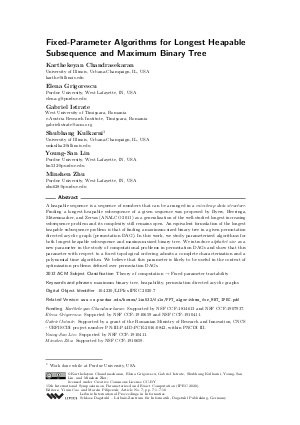Fixed-Parameter Algorithms for Longest Heapable Subsequence and Maximum Binary Tree
Authors Karthekeyan Chandrasekaran, Elena Grigorescu, Gabriel Istrate, Shubhang Kulkarni, Young-San Lin, Minshen Zhu
-
Part of:
Volume:
15th International Symposium on Parameterized and Exact Computation (IPEC 2020)
Part of: Series: Leibniz International Proceedings in Informatics (LIPIcs)
Part of: Conference: International Symposium on Parameterized and Exact Computation (IPEC) - License:
 Creative Commons Attribution 3.0 Unported license
Creative Commons Attribution 3.0 Unported license
- Publication Date: 2020-12-04
File

PDF
LIPIcs.IPEC.2020.7.pdf
- Filesize: 0.62 MB
- 16 pages
Document Identifiers
Related Versions
Subject Classification
ACM Subject Classification
- Theory of computation → Fixed parameter tractability
Keywords
- maximum binary tree
- heapability
- permutation directed acyclic graphs
Metrics
- Access Statistics
-
Total Accesses (updated on a weekly basis)
0Document
0Metadata
Abstract
A heapable sequence is a sequence of numbers that can be arranged in a min-heap data structure. Finding a longest heapable subsequence of a given sequence was proposed by Byers, Heeringa, Mitzenmacher, and Zervas (ANALCO 2011) as a generalization of the well-studied longest increasing subsequence problem and its complexity still remains open. An equivalent formulation of the longest heapable subsequence problem is that of finding a maximum-sized binary tree in a given permutation directed acyclic graph (permutation DAG). In this work, we study parameterized algorithms for both longest heapable subsequence and maximum-sized binary tree. We introduce alphabet size as a new parameter in the study of computational problems in permutation DAGs and show that this parameter with respect to a fixed topological ordering admits a complete characterization and a polynomial time algorithm. We believe that this parameter is likely to be useful in the context of optimization problems defined over permutation DAGs.
Cite As Get BibTex
Karthekeyan Chandrasekaran, Elena Grigorescu, Gabriel Istrate, Shubhang Kulkarni, Young-San Lin, and Minshen Zhu. Fixed-Parameter Algorithms for Longest Heapable Subsequence and Maximum Binary Tree. In 15th International Symposium on Parameterized and Exact Computation (IPEC 2020). Leibniz International Proceedings in Informatics (LIPIcs), Volume 180, pp. 7:1-7:16, Schloss Dagstuhl – Leibniz-Zentrum für Informatik (2020)
https://doi.org/10.4230/LIPIcs.IPEC.2020.7
BibTex
@InProceedings{chandrasekaran_et_al:LIPIcs.IPEC.2020.7,
author = {Chandrasekaran, Karthekeyan and Grigorescu, Elena and Istrate, Gabriel and Kulkarni, Shubhang and Lin, Young-San and Zhu, Minshen},
title = {{Fixed-Parameter Algorithms for Longest Heapable Subsequence and Maximum Binary Tree}},
booktitle = {15th International Symposium on Parameterized and Exact Computation (IPEC 2020)},
pages = {7:1--7:16},
series = {Leibniz International Proceedings in Informatics (LIPIcs)},
ISBN = {978-3-95977-172-6},
ISSN = {1868-8969},
year = {2020},
volume = {180},
editor = {Cao, Yixin and Pilipczuk, Marcin},
publisher = {Schloss Dagstuhl -- Leibniz-Zentrum f{\"u}r Informatik},
address = {Dagstuhl, Germany},
URL = {https://drops.dagstuhl.de/entities/document/10.4230/LIPIcs.IPEC.2020.7},
URN = {urn:nbn:de:0030-drops-133102},
doi = {10.4230/LIPIcs.IPEC.2020.7},
annote = {Keywords: maximum binary tree, heapability, permutation directed acyclic graphs}
}
Author Details
- West University of Timişoara, Romania
- e-Austria Research Institute, Timişoara, Romania
Funding
- Chandrasekaran, Karthekeyan: Supported by NSF CCF-1814613 and NSF CCF-1907937.
- Grigorescu, Elena: Supported by NSF CCF-1910659 and NSF CCF-1910411.
- Istrate, Gabriel: Supported by a grant of the Romanian Ministry of Research and Innovation, CNCS - UEFISCDI project number PN-III-P4-ID-PCE-2016-0842, within PNCDI III.
- Lin, Young-San: Supported by NSF CCF-1910411.
- Zhu, Minshen: Supported by NSF CCF-1910659.
References
-
János Balogh, Cosmin Bonchiş, Diana Diniş, Gabriel Istrate, and Ioan Todinca. The heapability of finite partial orders. Discrete Mathematics and Theoretical Computer Science, 22(1), 2020.

-
Anne-Laure Basdevant, Lucas Gerin, Jean-Baptiste Gouéré, and Arvind Singh. From Hammersley’s lines to Hammersley’s trees. Probability Theory and Related Fields, pages 1-51, 2016.

-
Anne-Laure Basdevant and Arvind Singh. Almost-sure asymptotic for the number of heaps inside a random sequence. Electronic Communications in Probability, 23(17), 2018.

-
Cosmin Bonchiş, Gabriel Istrate, and Vlad Rochian. The language (and series) of Hammersley-type processes. In Proceedings of the Eighth Conference on Machines Computation and Universality (MCU'18), volume 10881 of Lecture Notes in Computer Science, 2018.

-
John Byers, Brent Heeringa, Michael Mitzenmacher, and Georgios Zervas. Heapable sequences and subseqeuences. In Proceedings of the Eighth Workshop on Analytic Algorithmics and Combinatorics, ANALCO '11, pages 33-44, 2011.

- Karthekeyan Chandrasekaran, Elena Grigorescu, Gabriel Istrate, Shubhang Kulkarni, Young-San Lin, and Minshen Zhu. The maximum binary tree problem. In Proceedings of the 32nd European Symposium on Algorithms (ESA'20), to appear, 2020. arXiv preprint: 1909.07915. URL: http://arxiv.org/abs/1909.07915.
-
Rodney G Downey and Michael Ralph Fellows. Parameterized complexity. Springer Verlag, 2012.

-
Martin Charles Golumbic. Chapter 7 - permutation graphs. In Martin Charles Golumbic, editor, Algorithmic Graph Theory and Perfect Graphs, pages 157-170. Academic Press, 1980.

-
Gabriel Istrate and Cosmin Bonchiş. Partition into heapable sequences, heap tableaux and a multiset extension of Hammersley’s process. In Proceedings of the 26th Annual Symposium on Combinatorial Pattern Matching (CPM'15), Ischia, Italy, volume 9133 of Lecture Notes in Computer Science, pages 261-271. Springer, 2015.

-
Gabriel Istrate and Cosmin Bonchiş. Heapability, interactive particle systems, partial orders: Results and open problems. In Proceedings of the 18th International Conference on Descriptional Complexity of Formal Systems (DCFS'2016), Bucharest, Romania, volume 9777 of Lecture Notes in Computer Science, pages 18-28. Springer, 2016.

-
A. Pnueli, A. Lempel, and S. Even. Transitive orientation of graphs and identification of permutation graphs. Canadian Journal of Mathematics, 23(1):160–175, 1971.

-
Jaclyn Porfilio. A combinatorial characterization of heapability. Master’s thesis, Williams College, 2015.

-
Dan Romik. The surprising mathematics of longest increasing subsequences. Cambridge University Press, 2015.

